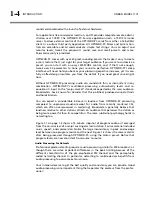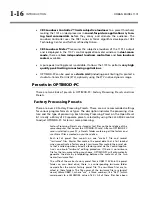
OPTIMOD-PC
INTRODUCTION
1-5
Conventional AM, FM, or TV audio processors that employ preemphasis/deemphasis
and/or clipping peak limiters do not work well with perceptual audio coders such as
Orban’s Opticodec-PC® MPEG-4 AAC/HE-AACv2 streaming encoder. The preempha-
sis/deemphasis limiting in these processors unnecessarily limits high frequency head-
room. Further, their clipping limiters create high frequency components—
distortion—that the perceptual audio coders would otherwise not encode. None of
these devices have the full set of audio and control features found in OPTIMOD-PC.
Peak clipping sounds bad even in uncompressed digital channels because these
channels do not rely on preemphasis/deemphasis to reduce audible distortion. In-
stead of peak clipping, OPTIMOD-PC uses look-ahead limiting to protect the follow-
ing channel from peak overload.
Orban’s PreCode™ technology manipulates several aspects of the audio to minimize
artifacts caused by low bitrate codecs, ensuring consistent loudness and texture from
one source to the next. PreCode includes special audio band detection algorithms
that are energy and spectrum aware. This can improve codec performance on some
codecs by reducing audio processing induced codec artifacts, even with program ma-
terial that has been preprocessed by other processing than Optimod. There are sev-
eral factory presets tuned specifically for low performance, low bitrate codecs.
Unlike some other codec preprocessors, PreCode does not suck the punch and life
out of music. Instead, PreCode strikes an artistic balance between liveliness and arti-
fact reduction, ensuring that the cure is never worse than the disease.
Controlling Program Levels in a Playout System before OPTIMOD-PC
To optimize the consistency of a broadcast or netcast, preprocessing each program
element via OPTIMOD-PC before it is stored on a playout system is not as effective as
processing the playout system’s output in real time using OPTIMOD-PC. The latter
technique maximizes the smoothness of transition between program elements and
makes voice from announcers or presenters merge smoothly into the program flow,
even if the announcer is talking over music.
You can help OPTIMOD-PC operate at its best by setting the level of each program
element when you load it into the playout system. Many audio editing programs
permit a sound file to be “peak-normalized,” which amplifies or attenuates the level
of the file to force the highest instantaneous peak to reach 0 dBfs. This is a very
poor way to set the levels of different audio files on a playout system. Absolute
peak levels have nothing to do with loudness, so peak-normalized files are likely to
have widely varying loudness levels depending on the typical peak-to-average ratio
of the audio in the file. Because of over-use of peak limiting in today’s CD mastering
(which has the unfortunate side-effect of sucking the life and punch out of music),
the average level of a CD produced in the ‘80s can be as much as 15 dB lower than
the average level of a CD produced today. When a playout system segues two such
disparate peak-normalized files, this can cause audible loudness inconsistencies in
your broadcast/netcast while OPTIMOD-PC’s AGC section corrects the loudness.
OPTIMOD-PC’s AGC section uses window-gating technology to minimize the audibil-
ity of such gain riding. Even so, 15 dB of level correction can take several seconds
and is determined by OPTIMOD-PC’s AGC release time setting.
Содержание Optimod-PC 1101
Страница 4: ......
Страница 14: ......
Страница 121: ...OPTIMOD PC OPERATION 3 1 Section 3 Operation Figure 3 1 The OPTIMOD PC Control Application...
Страница 192: ...3 72 OPERATION ORBAN MODEL 1101...
Страница 204: ......
Страница 210: ......
Страница 212: ...5 2 UNINSTALLATION ORBAN MODEL 1101...
Страница 236: ......
















































